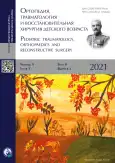半椎体背侧切除术时,术中神经生理监测的使用特点
- 作者: Vissarionov S.V.1, Syundyukov A.R.2, Nikolaev N.S.2,3, Kuzmina V.A.2, Kornyakov P.N.2, Maksimov M.N.2, Mikhailova I.V.3
-
隶属关系:
- H. Turner National Medical Research Center for Сhildren’s Orthopedics and Trauma Surgery
- Federal Center for Traumatology, Orthopedics and Arthroplasty
- Chuvash State University named after I.N. Ulyanov
- 期: 卷 9, 编号 3 (2021)
- 页面: 267-276
- 栏目: Original Study Article
- URL: https://bakhtiniada.ru/turner/article/view/61946
- DOI: https://doi.org/10.17816/PTORS61946
- ID: 61946
如何引用文章
详细
论证。先天性脊椎形成障碍是儿童常见的病理。术中神经生理学监测是一项强制性程序,由于神经结构的不成熟以及在幼儿中使用吸入麻醉剂,该程序可能不够有效。
目的是研究先天性脊柱畸形患儿半椎体背侧切除术中神经生理监测的特点。
材料和方法。42名1-17岁的先天性脊柱畸形患者接受了46次从孤立的背侧入路(egg-shell技术) 切除异常椎骨。手术阶段的术中神经生理监测包括肌肉松弛试验(TOF)、运动皮层经颅电刺激(TCeMEP)、神经入路控制(N. Proxy)和椎弓根螺钉的正确放置(Screw Integrity)),肌电图的EMG记录。螺钉放置的正确性通过Gerzbien方法评估,神经系统疾病的存在 - 通过Frenkel量表。通过调节吸入麻醉剂(Sevoran)的供应,控制其对运动诱发电位的影响,并确定其对患者年龄的依赖性。
结果。患者的平均年龄为7.7 ± 4.5岁。TOF值为80.5 ± 17%。41名患者中,N. Proxy测试不显着;在1名患者中,8-12 mA值不需要改变螺钉的轨迹。从塞沃兰给药开始,54.8%的患者术中记录了来自所有受试肌肉的运动诱发电位,8岁以上的儿童为92.8%,在8岁以下儿童中,35.7%的病例在其年龄组中。在其余患者中,在服用塞沃兰的背景下,大腿和小腿肌肉最常缺少运动诱发电位:8岁以上儿童中7.2%的病例,8岁以下儿童中83.3%的患者;在7.2%的8岁以下患者中,最初没有从任何肌肉记录到运动诱发电位。因此,我们无法充分评估19名患者(45.2%)运动通路的传导情况,其中13名患者(30.9%)停止使用塞沃兰,使得100%的患者能够从所有受试肌肉获得术中运动诱发电位。为了充分管理麻醉5(50%)名1-4岁患者和1名6岁患者(5.6%)未取消,并记录了腹部肌肉的运动诱发电位,这使得仅评估传导成为可能在胸椎水平,需要外科医生在矫正操作期间提高警觉性。
结论。半椎体背侧切除术中的神经生理学监测得到证实、有效,并且可以控制脊柱操作过程中的神经系统并发症
关键词
作者简介
Sergei Vissarionov
H. Turner National Medical Research Center for Сhildren’s Orthopedics and Trauma Surgery
Email: vissarionovs@gmail.com
ORCID iD: 0000-0003-4235-5048
SPIN 代码: 7125-4930
MD, PhD, D.Sc., Professor, Corresponding Member of RAS
俄罗斯联邦, Saint PetersburgAyrat Syundyukov
Federal Center for Traumatology, Orthopedics and Arthroplasty
编辑信件的主要联系方式.
Email: sndk-ar@yandex.ru
ORCID iD: 0000-0001-8276-9216
SPIN 代码: 6275-4184
MD, PhD
俄罗斯联邦, 33, Fyodor Gladkov str., Cheboksary, Chuvash Republic, 428020Nikolay Nikolaev
Federal Center for Traumatology, Orthopedics and Arthroplasty; Chuvash State University named after I.N. Ulyanov
Email: nikolaevns@mail.ru
ORCID iD: 0000-0002-1560-470X
SPIN 代码: 8723-9840
MD, PhD, D.Sc., Professor
俄罗斯联邦, 33, Fyodor Gladkov str., Cheboksary, Chuvash Republic, 428020; CheboksaryValentina Kuzmina
Federal Center for Traumatology, Orthopedics and Arthroplasty
Email: kuzmina_va@orthoscheb.com
ORCID iD: 0000-0003-3159-4764
SPIN 代码: 9577-9200
MD, doctor of functional diagnostics
俄罗斯联邦, 33, Fyodor Gladkov str., Cheboksary, Chuvash Republic, 428020Pavel Kornyakov
Federal Center for Traumatology, Orthopedics and Arthroplasty
Email: pashat-1000@mail.ru
ORCID iD: 0000-0002-7124-5473
SPIN 代码: 9706-1851
MD, orthopedic and trauma surgeon
俄罗斯联邦, 33, Fyodor Gladkov str., Cheboksary, Chuvash Republic, 428020Maxim Maksimov
Federal Center for Traumatology, Orthopedics and Arthroplasty
Email: fc@orthoscheb.com
ORCID iD: 0000-0003-3762-4864
SPIN 代码: 6031-8080
MD, anesthesiologist-resuscitator
俄罗斯联邦, 33, Fyodor Gladkov str., Cheboksary, Chuvash Republic, 428020Irina Mikhailova
Chuvash State University named after I.N. Ulyanov
Email: ira1840@rambler.ru
ORCID iD: 0000-0001-7665-2572
SPIN 代码: 1998-0610
MD, Associate Professor
俄罗斯联邦, Cheboksary参考
- Ul’rikh EV. Spinal anomalies in children: A guide for doctors. Saint Petersburg: Sotis; 1995. (In Russ.)
- Udalova IG, Mikhaylovskiy MV. Neurological complications in scoliosis surgery. Khirurgiya pozvonochnika. 2013;(3):38−43. (In Russ.)
- Crostelli M, Mazza O, Mariani M. Posterior approach lumbar and thoracolumbar hemivertebra resection in congenital scoliosis in children under 10 years of age: results with 3 years mean follow up. Eur Spine J. 2014;23(1):209-215. doi: 10.1007/s00586-013-2933-z
- Klemme WR, Polly DW Jr, Orchowski JR. Hemivertebral excision for congenital scoliosis in very young children. J Pediatr Orthop. 2001;21(6):761−764.
- Vissarionov SV, Syundyukov AR, Kokushin DN. Comparative analysis of surgical treatment of preschool children with congenital deformity of the spine with isolated hemivertebrae from combined and dorsal approaches. Ortopediya, travmatologiya i vosstanovitel’naya khirurgiya detskogo vozrasta. 2019;7(4):5–14. (In Russ.)
- Guo J, Zhang J, Wang S, et al. Surgical outcomes and complications of posterior hemivertebra resection in children younger than 5 years old. J Orthop Surg Res. 2016;11(1):48. doi: 10.1186/s13018-016-0381-2
- Li J, Lü GH, Wang B, et al. Pedicle screw implantation in the thoracic and lumbar spine of 1-4-year-old children: evaluating the safety and accuracy by a computer tomography follow-up. J Spinal Disord Tech. 2013;26(2):E46−52. doi: 10.1097/BSD.0b013e31825d5c87
- Wang S, Zhang J, Qiu G, et al. Posterior hemivertebra resection with bisegmental fusion for congenital scoliosis: more than 3 year outcomes and analysis of unanticipated surgeries. Eur Spine J. 2013;22(2):387−393. doi: 10.1007/s00586-012-2577-4
- Khabirov FA. Guidelines for clinical neurology of spine. Kazan: Medicine; 2006. (In Russ.)
- Wright N. P141. Instrumented extreme lateral interbody fusion (XLIF) through a single approach. Spine J. 2005;5(4 Suppl.):S177–S178. doi: 10.1016/j.spinee.2005.05.356
- Auerbach JD, Lenke LG, Bridwell KH, et al. Major complications and comparison between 3-column osteotomy techniques in 105 consecutive spinal deformity procedures. Spine (Phila Pa 1976). 2012;37(14):1198−210. doi: 10.1097/BRS.0b013e31824fffde
- Gurskaya OE. Electrophysiological monitoring of the central nervous system. Saint Petersburg: ONFD; 2015. (In Russ.)
- Hit MA, Kolesov SV, Kolbovsky DA, Morozova NS. The role of intraoperative neurophysiological monitoring in prevention of postoperative neurological complications in scoliotic spinal deformation surgery. Neuromucular diseases. 2014;(2):36−41. (In Russ.)
- Schekutev GA. Neurophysiological researches in clinic research institute of neurosurgery named after NN Burdenko. Moscow: Antidor; 2001. (In Russ.)
- Nikitin SS, Kurenkov AL. Magnetic stimulation in the diagnosis and treatment of diseases of the nervous system. A guide for doctors. Moscow: SAShKO; 2003. (In Russ.)
- Müller K, Kass-Iliyya F, Reitz M. Ontogeny of ipsilateral corticospinal projections: a developmental study with transcranial magnetic stimulation. Ann Neurol. 1997;42(5):705−711. DOI: 10 1002/ana 410420506
- Simon M, Borges L. Intramedullary spinal cord tumor resection. In: Simon MV (ed). Intraoperative clinical neurophysiology. A comprehensive guide to monitoring and mapping. New York: Demosmedical; 2010. P. 179–208.
- Deiner S. Highlights of anesthetic considerations for intraoperative neuromonitoring. Semin Cardiothorac Vasc Anesth. 2010;14(1):51−53. doi: 10.1177/1089253210362792
- Kalkman CJ, Drummond JC, Ribberink AA. Low concentrations of isoflurane abolish motor evoked responses to transcranial electrical stimulation during nitrous oxide/opioid anesthesia in humans. Anesthesia and Analgesia. 1991;73(4):410−415. doi: 10.1213/00000539-199110000-00008
- Sloan TB. Anesthetic effects on electrophysiologic recordings. J Clin Neurophysiol. 1998;15(3):217−226. doi: 10.1097/00004691-199805000-00005
- Bollini G, Docquier PL, Jouve JL. Hemivertebrectomy in early-onset scoliosis. In: Akbarnia B, Yazici M, Thompson G. (eds.). The growing spine. Berlin, Heidelberg: Springer; 2016. P. 555−569. doi: 10.1007/978-3-662-48284-1_31
- Belova AN, Baldova SN. Neurophysiological intraoperative monitoring during operations on the spine and spinal cord (literature review). Russkiy meditsinskiy zhurnal. 2016;(23):1569−1574. (In Russ.)
- Novikov VV, Novikova MV, Tsvetovskiy SB, et al. Prevention of neurological complications during surgical correction of gross deformities of the spine. Khirurgiya pozvonochnika. 2011;(3):66–76. (In Russ.)
- Buzunov AV, Vasyura AS, Dolotin DN, et al. Multimodal approach in intraoperative neuromonitoring of the spinal cord during the correction of spinal deformities. Khirurgiya pozvonochnika. 2021;18(1):31–38. (In Russ.). doi: 10.14531/ss2021.1.31-38
补充文件









